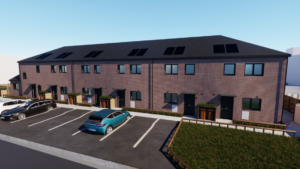How far can the CLT model go?
 One crisp October morning a group of Cheshire residents boarded a minibus and headed off for Shropshire. But this was no ordinary day trip. They weren’t heading for a foody weekend in Ludlow. This was a group of ordinary middle-class residents concerned more about housing than couscous or micro-breweries. A group, in fact, so concerned by the growing housing issues that they spent their weekend looking at a neighbouring county’s attempt to address the issue.
One crisp October morning a group of Cheshire residents boarded a minibus and headed off for Shropshire. But this was no ordinary day trip. They weren’t heading for a foody weekend in Ludlow. This was a group of ordinary middle-class residents concerned more about housing than couscous or micro-breweries. A group, in fact, so concerned by the growing housing issues that they spent their weekend looking at a neighbouring county’s attempt to address the issue.
When they reached their destination – the delightful town of Bishop’s Castle – what they would experience would shape their thinking of how to attempt to solve the affordability issue of housing in rural towns and villages forever.
They took experience and knowledge back on the minibus to Cheshire and once there, put it into action.
The trip was organised by the Cheshire Community Land Trust (CLT) project, a two-year multi-agency funded project aimed at creating CLTs in Cheshire. Among its funders are both of Cheshire’s local authorities and five housing associations, who have identified CLTs as part of the solution to affordable housing, and enabled a project which offers support and guidance to communities wishing to develop CLTs in Cheshire.
But back to the coach trip. What is this magic solution they went in search of? What is the secret Shropshire holds?
Well, in fact there is no secret. Shropshire just happens to be home to just one of the country’s 130-something Community Land Trusts. It is an approach to affordable housing that has cross-party political support and there’s even been a surprising amount of funding knocking about over the last few years to help get projects off the ground. Even the trip itself was paid for with funding from the National CLT Network’s innovative See It and Believe It fund.
When the Cheshire group stepped off the coach and saw for themselves the modern eco-efficient homes providing vital housing for residents who would have either had to move out of the area or become homeless, their enthusiasm and surprise was palpable. This was quickly followed by a hunger for knowledge. ‘How is this achievable?’, they asked. And the answer lies not in how the homes are constructed, or the area they are built in, but how the land is owned and the homes are managed. Placing both these facets in the hands of a CLT preserves the land for community benefit forever.
Ok, here’s the technical stuff in what, overall, is a brilliantly simple idea. The CLT model has a mechanism which separates the land value from the property value – the mechanism missing from the open market housing sector which leads to spiralling levels of unaffordability for millions of people.
A key prerequisite of CLTs is that their membership is open to everyone in the local community. This not only ensures accountability of the trust but also galvanises communities as they come together to meet their housing needs head on.
It means that, as the trust develops, local people have a more direct say in the design, character and function of the homes they build. Thus the process itself results in a micro-level analysis of local housing needs which might be otherwise unachievable. This ultimately delivers housing which is more sympathetic to its physical and social environment, which in turn increases the social and economic sustainability of places at risk of the onslaught of unfettered market forces.
And so far, the evidence suggests that CLTs rarely stop after their first development, they continue. One in Cumbria even took over the local pub when it closed halfway through building their first houses. Another has provided workspace units. Yes, the CLT model usually allows it to take on other assets and preserve them for their community.
CLTs and interesting to everyone effected by or interested in housing issues. Whether a middle-income earner unable to live within commutable reach of their place of work, or someone with no home at all, how far can the CLT movement reach in tackling all levels of need?
The evidence as a basis for developing affordable housing has been well-proven but this is easier to achieve in areas where high levels of social capital abound. Additional resources could be required in areas where individuals feel disenfranchised not just from the housing market, but from social and political spheres too. In providing individuals and communities with ownership and the ability to create assets and resources of their own, could the CLT model prove to be as much a part of their solution as they have been to the wider issue of affordability?
One of the key messages the group came away from Shropshire with was the level of innovation the CLT model offers, from community-owned houses to community-owned pubs, shops, workspaces, orchards and even power stations.
The group re-boarded the minibus back to Cheshire buoyed by the level of knowledge and inspiration they had gleaned.
The food, incidentally, was delicious.
P.S. Since the study visit to Shropshire, a number of the group have established the South Cheshire Borders CLT. They are currently in discussion with landowners and are hoping to develop a range of projects potentially including building a new state-of-the-art health centre in Malpas.















